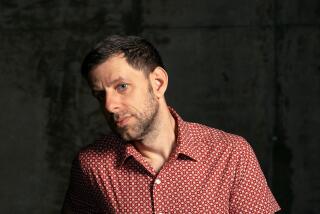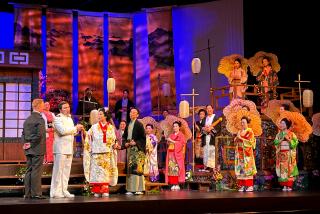Roger Wagner, Choral Music Leader, Dies at 78
Roger Wagner, the mercurial conductor who became a preeminent choral music figure nationally and locally in the course of a career that spanned nearly five decades, died Thursday in France, his native country. He was 78.
Paul Salamunovich, a former Wagner assistant who took over the Roger Wagner Chorale in 1991, said his mentor had died after a years-long battle with cancer that spread throughout his body after attacking his prostate gland.
Several weeks ago, Wagner decided to return to France to die after his struggle against cancer proved hopeless. He died in Dijon, his mother’s birthplace.
One of Wagner’s last conversations, Salamunovich said, was with Robert Shaw, the internationally acclaimed choral director who has lived in France for several years. Shaw and Wagner had long been considered the dominant figures in American choral music.
In the mid-1940s, Wagner--then a church organist and choir director--took a handful of Los Angeles singers and shaped them into the Roger Wagner Chorale. For years, the group made recordings and toured in the United States, Europe and Latin America.
With the opening of the Music Center of Los Angeles County two decades later, Wagner co-founded the larger Los Angeles Master Chorale. It became the resident chorale of the new arts complex, performing with the Los Angeles Philharmonic and presenting its own concerts.
Praised by critics as a choral conductor who drew rich sounds from his singers, Wagner possessed the flair and energy of a showman. He was passionate about music and demanding of the people around him, causing some to label him as self-centered and dominating.
He had a quick, frequently wicked wit. And although Wagner possessed considerable personal charm, it could be easily overshadowed by his acerbic tongue.
Sometimes his sarcasm was benign, as when he greeted his doting “Messiah” sing-along audiences: “I hope you’re in better voice than you were last year.”
But faced with his verbal broadsides, singers frequently complained that rehearsal sessions were exercises in abuse. Wagner drew reprimands from the American Guild of Musical Artists for his rehearsal practices.
“There’s no question that Roger vents widely,” an alto once said. “He clearly uses the group as therapy.”
But Wagner could also be generous, loaning singers large sums of money that were never repaid. He was concerned about the welfare of his singers, even though “fighting and screaming” was his style, one singer said a few years ago.
For his part, Wagner said he employed “disciplinary action to get the right musical response.”
An authority on medieval and Renaissance music, Wagner wrote scholarly articles and was a teacher, spending 22 years on the UCLA faculty.
He was noted for spotting new talent and worked with opera star Marilyn Horne and singer Marni Nixon when they were just schoolgirls.
Wagner once told an interviewer that he felt lucky to have known and worked with the likes of Arnold Schoenberg, Igor Stravinsky, Arthur Honegger, Francis Poulenc, Darius Milhaud and Nadia Boulanger.
Off the musical stage, Wagner was a self-confessed fitness fanatic and tennis nut. But he also smoked a pipe, enjoyed fine wine and food and loved driving Cadillac convertibles.
In the mid-1980s, Wagner waged a public battle with the Master Chorale board when it sought to replace him with another music director. The board cited Wagner’s age--then 70--and the need for an orderly transition.
But Wagner, insisting that there had been no decline in the chorale’s quality, charged that he was a victim of Music Center politics. “You can’t treat a conductor like a J.C. Penney clerk--just replace him,” he said.
But he was replaced, in 1986, by Scottish conductor John Currie. Wagner was given the title of music director laureate and during a concert in early 1987 he collapsed on stage from the effects of a subdural hematoma above his brain.
Wagner, however, was soon back at work, taking up new teaching activities and continuing to conduct his Roger Wagner Chorale.
(Currie was given a five-year contract and opted not to renew it after a troubling period in which attendance and singers’ morale dropped. He was replaced in 1991 by Salamunovich.)
Wagner was born in LePuy, France, where he was exposed to music at an early age by his father, who was the organist at the Cathedral of Dijon. Wagner was 7 when his family came to Los Angeles, where his father was also a church organist.
He intended to be a priest, but at the age of 17 Wagner decided to pursue a career in music. He returned to France, spending five years studying organ and composition and researching church music. While a student, he also served a hitch in the French Army.
Returning to Los Angeles in the mid-1930s, Wagner sang in the MGM studio chorus, where he worked with Jeanette MacDonald and Nelson Eddy in the 1935 film “Naughty Marietta” and other movies.
A short time later, he was hired as organist and music director of St. Joseph’s Church in downtown Los Angeles, a post he held for 30 years. Annual choral concerts drew music lovers to St. Joseph’s and in 1945 led to Wagner’s selection as supervisor of youth choruses for the Los Angeles Bureau of Music.
“All over the city, there were small choral groups, all singing for the bureau,” Wagner said in a 1982 Times interview. “As citywide leader, I soon found that in each group there were one or two outstanding singers. I began to bring them together.”
The result was the Los Angeles Concert Youth Chorus, which became the Roger Wagner Chorale in 1948.
In the beginning, Wagner put his own money into the group, even mortgaging his home and borrowing on his insurance for a tour of England. The singers, however, had to pay their own way.
During the 1950s, there were tours of Europe and Latin America and after a 1957 appearance at New York’s Town Hall, New York Times music critic Howard Taubman called the group “a highly disciplined ensemble which can cope with anything.” After a 1955 performance with conductor Leopold Stokowski, the conductor wrote Wagner, “There are supremely great choruses in England and Italy, but yours is second to none in the world.”
The chorale sang for movies and even played rock dates, one with Pink Floyd in San Francisco. Wagner served as guest conductor with choruses around the world, as well as conducting an occasional symphony concert.
In 1964, Wagner--together with the late Z. Wayne Griffin and the Los Angeles Junior Chamber of Commerce--founded the Master Chorale, an aggregation of more than 100 professional and amateur singers.
The Master Chorale functioned as a Los Angeles-based group, while the separate Roger Wagner Chorale--with 21 to 40 singers and a pianist--toured. Wagner maintained a grueling tour schedule of one-night stands well into the 1980s.
When the Roger Wagner Chorale observed its official silver anniversary in 1972 (the founding date was then put at 1947), Wagner told The Times, “I’m proud of my career. I’m proud of having been able to present the great choral masterpieces in professional performances. I’m proud of having cultivated individual talents within my organizations. I’m proud of our records.”
Critics praised Wagner for his attention to shaping vocal lines and drawing rich sounds from his singers. But some were not so pleased with his orchestral conducting. In Wagner’s final appearance as music director of the Master Chorale in April, 1986, Times music critic Martin Bernheimer wrote, “Wagner never knew how to deal with instruments.”
On Thursday, Bernheimer remembered him with whimsy and fondness:
“At his best, Roger Wagner was something of a genius on the podium, and a splendidly feisty old walrus off it. He knew how to blend vocal sounds with uncanny flexibility, sensuality, color and point. His interpretive ideas were particularly compelling in the French repertory that he inherited and adored. He was a showman par excellence, and, luckily, his generous ego was matched by his talent.
“He was frustrated by the knowledge that orchestra conductors invariably command greater glory than choral conductors. But he bore the burden with a winning sense of humor--even self-mockery. It will be impossible to forget the Orange County fund-raiser in which he meowed Rossini’s whimsical “Cat Duet” (the top line of course) in close harmony with his younger colleague and rival, William Hall.”
For his part, Wagner considered himself a perfectionist who accepted the blame when things went wrong. “I have a concept of sound, and that sound has to be right,” he once said. “I have to have that wonderful limpid sound. . . . The soul of the piece is what counts, and when a conductor cannot transmit it to his singers so that they can transmit it to the audience, it’s a sad day indeed.”
Wagner worked to increase the professionalism of choral singing, bemoaning the fact that professional orchestras perform with amateur choruses: “Why, the guy who pulls the curtain gets more money than the singers. It’s a tradition by now--and it’s wrong.”
He reveled in working with the young, saying, “I’ve encouraged the really young talents. . . . I think that is one of my contributions. I’m in exciting work and I never get tired of it.”
Survivors include his longtime friend, Donna Hackley, who was with him when he died; his estranged wife, Janice; a son, Richard; two daughters, Jeannine and Jacki, and one grandson.
Funeral and memorial services are pending in Los Angeles.
More to Read
The biggest entertainment stories
Get our big stories about Hollywood, film, television, music, arts, culture and more right in your inbox as soon as they publish.
You may occasionally receive promotional content from the Los Angeles Times.










